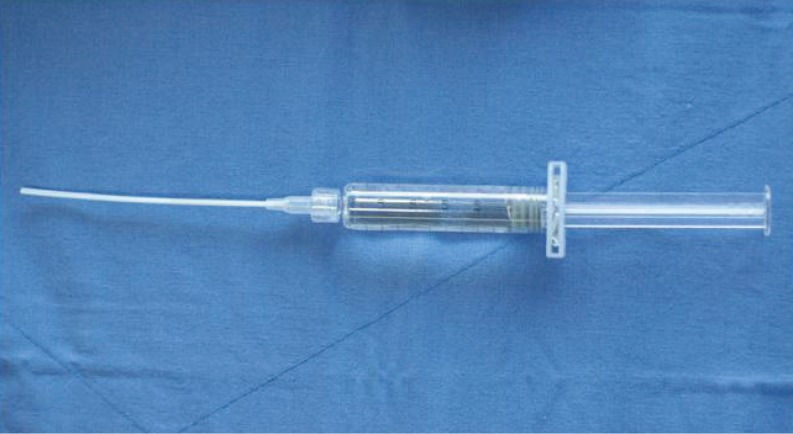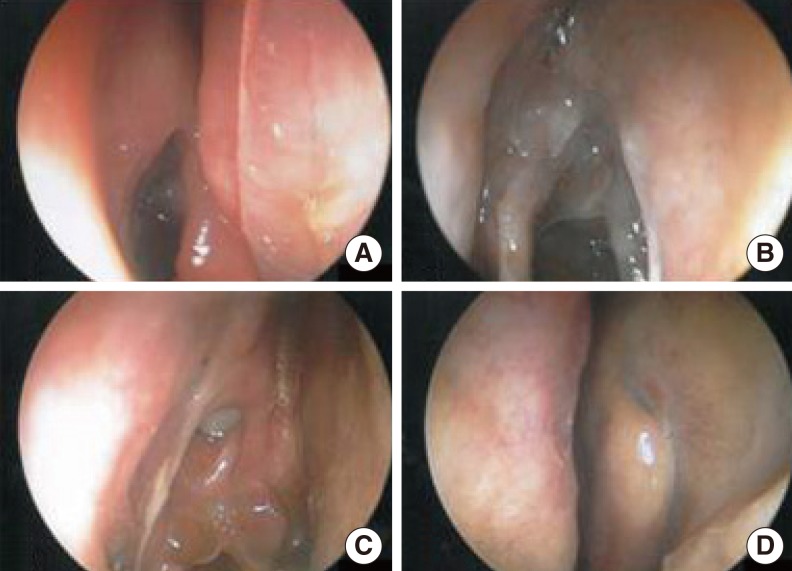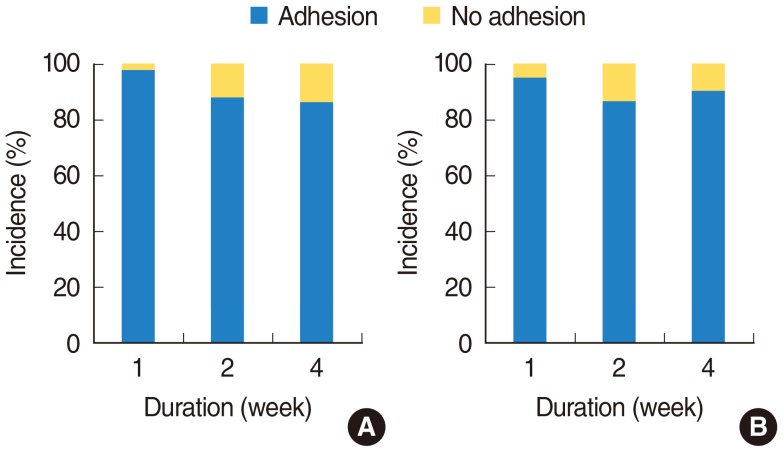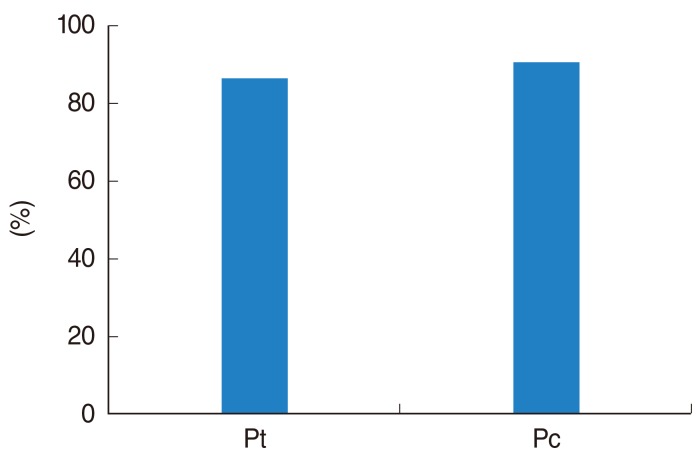Clin Exp Otorhinolaryngol.
2014 Mar;7(1):30-35.
A Randomized, Multi-Center, Single Blind, Active-Controlled, Matched Pairs Clinical Study to Evaluate Prevention of Adhesion Formation and Safety of HyFence in Patients After Endoscopic Sinus Surgery
- Affiliations
-
- 1Department of Otorhinolaryngology, Bundang CHA Hospital, Cha University College of Medicine, Seongnam, Korea.
- 2Department of Otorhinolaryngology-Head and Neck Surgery, Korea University Guro Hospital, Seoul, Korea. lhman@korea.ac.kr
- 3Medical Devices Clinical Trial Center, Korea University Guro Hospital, Seoul, Korea.
- 4Department of Otolaryngology-Head and Neck Surgery, St. Mary's Hospital, The Catholic University of Korea College of Medicine, Seoul, Korea.
Abstract
OBJECTIVES
Recurrent mucosal disease and anatomic obstruction are commonly cited causes of failed endoscopic sinus surgery (ESS). Hyaluronic acid (HA) has been reported to reduce scarring and to promote wound healing in sinonasal surgery. HyFence is HA stabilized by 1, 4-butandiol diglycidyl ether, which makes it less-water-soluble and highly viscoelastic. The purpose of this study is to examine the anti-adhesion effect of HyFence after ESS compared to that of HA-CMC (Guardix-Sol).
METHODS
Seventy-four patients with chronic rhinosinusitis who underwent ESS were included in the study. After the ESS procedure, Merocel was placed in the ethmoidectomized areas of the both sides. Five milliliters of Guardix-Sol was then applied to the Merocel of one side and HyFence LV was applied to the other side. The effect of the agents was evaluated at one, two, and four weeks after surgery by endoscopic examination. The severity of adhesion, edema, infection and complications were evaluated.
RESULTS
There was no significant difference in the incidence of postoperative adhesion between the HyFence group and the Guardix-Sol group (P>0.05). Mean postoperative grades of edema and infection showed no significant difference between groups (P>0.05). There was no significant postoperative complications associated with either anti-adhesion agent (P>0.05).
CONCLUSION
HyFence has equivalent anti-adhesion effect compared to Guardix-Sol following ESS.
MeSH Terms
Figure
Reference
-
1. Smith LF, Brindley PC. Indications, evaluation, complications, and results of functional endoscopic sinus surgery in 200 patients. Otolaryngol Head Neck Surg. 1993; 6. 108(6):688–696. PMID: 8516006.
Article2. Ramadan HH. Surgical causes of failure in endoscopic sinus surgery. Laryngoscope. 1999; 1. 109(1):27–29. PMID: 9917035.
Article3. Chambers DW, Davis WE, Cook PR, Nishioka GJ, Rudman DT. Long-term outcome analysis of functional endoscopic sinus surgery: correlation of symptoms with endoscopic examination findings and potential prognostic variables. Laryngoscope. 1997; 4. 107(4):504–510. PMID: 9111381.
Article4. Chung JH, Cosenza MJ, Rahbar R, Metson RB. Mitomycin C for the prevention of adhesion formation after endoscopic sinus surgery: a randomized, controlled study. Otolaryngol Head Neck Surg. 2002; 5. 126(5):468–474. PMID: 12075219.
Article5. Roozitalab MH, Amirahmadi M, Namazi MR. Results of the application of intraoperative mitomycin C in dacryocystorhinostomy. Eur J Ophthalmol. 2004; Nov-Dec. 14(6):461–463. PMID: 15638092.
Article6. Berlucchi M, Castelnuovo P, Vincenzi A, Morra B, Pasquini E. Endoscopic outcomes of resorbable nasal packing after functional endoscopic sinus surgery: a multicenter prospective randomized controlled study. Eur Arch Otorhinolaryngol. 2009; 6. 266(6):839–845. PMID: 18946677.
Article7. Elkins TE, Ling FW, Ahokas RA, Abdella TN, Homsey CA, Malinak LR. Adhesion prevention by solutions of sodium carboxymethylcellulose in the rat. II. Fertil Steril. 1984; 6. 41(6):929–932. PMID: 6202560.
Article8. Kim JH, Lee JH, Yoon JH, Chang JH, Bae JH, Kim KS. Antiadhesive effect of the mixed solution of sodium hyaluronate and sodium carboxymethylcellulose after endoscopic sinus surgery. Am J Rhinol. 2007; Jan-Feb. 21(1):95–99. PMID: 17283569.
Article9. Gago LA, Saed GM, Chauhan S, Elhammady EF, Diamond MP. Seprafilm (modified hyaluronic acid and carboxymethylcellulose) acts as a physical barrier. Fertil Steril. 2003; 9. 80(3):612–616. PMID: 12969707.
Article10. Kimmelman CP, Edelstein DR, Cheng HJ. Sepragel sinus (hylan B) as a postsurgical dressing for endoscopic sinus surgery. Otolaryngol Head Neck Surg. 2001; 12. 125(6):603–608. PMID: 11743460.
Article11. Soldati D, Rahm F, Pasche P. Mucosal wound healing after nasal surgery: a controlled clinical trial on the efficacy of hyaluronic acid containing cream. Drugs Exp Clin Res. 1999; 25(6):253–261. PMID: 10713863.12. Xu G, Chen HX, Wen WP, Shi JB, Li Y. Clinical evaluation of local application of Merogel after endoscopic sinus surgery. Zhonghua Er Bi Yan Hou Ke Za Zhi. 2003; 4. 38(2):95–97. PMID: 12889103.13. Li G, Feghali JG, Dinces E, McElveen J, van de Water TR. Evaluation of esterified hyaluronic acid as middle ear-packing material. Arch Otolaryngol Head Neck Surg. 2001; 5. 127(5):534–539. PMID: 11346429.
Article14. Ozturk K, Yaman H, Cihat Avunduk M, Arbag H, Keles B, Uyar Y. Effectiveness of MeroGel hyaluronic acid on tympanic membrane perforations. Acta Otolaryngol. 2006; 12. 126(11):1158–1163. PMID: 17050307.
Article15. Erturk S, Yuceyar S, Temiz M, Ekci B, Sakoglu N, Balci H, et al. Effects of hyaluronic acid-carboxymethylcellulose antiadhesion barrier on ischemic colonic anastomosis: an experimental study. Dis Colon Rectum. 2003; 4. 46(4):529–534. PMID: 12682549.16. Hellebrekers BW, Trimbos-Kemper TC, Trimbos JB, Emeis JJ, Kooistra T. Use of fibrinolytic agents in the prevention of postoperative adhesion formation. Fertil Steril. 2000; 8. 74(2):203–212. PMID: 10927033.
Article17. Johns DB, Keyport GM, Hoehler F, diZerega GS. Intergel Adhesion Prevention Study Group. Reduction of postsurgical adhesions with Intergel adhesion prevention solution: a multicenter study of safety and efficacy after conservative gynecologic surgery. Fertil Steril. 2001; 9. 76(3):595–604. PMID: 11532487.18. Ugwoke MI, Agu RU, Jorissen M, Augustijns P, Sciot R, Verbeke N, et al. Toxicological investigations of the effects carboxymethylcellulose on ciliary beat frequency of human nasal epithelial cells in primary suspension culture and in vivo on rabbit nasal mucosa. Int J Pharm. 2000; 9. 205(1-2):43–51. PMID: 11000541.
Article
- Full Text Links
- Actions
-
Cited
- CITED
-
- Close
- Share
- Similar articles
-
- Efficacy and Safety of Guardcel Nasal Packing After Endoscopic Sinus Surgery: A Prospective, Single-Blind, Randomized Controlled Study
- Notice of Retraction: Pak CS, et al. A Phase III, Randomized, Double-Blind, Matched-Pairs, Active-Controlled Clinical Trial and Preclinical Animal Study to Compare the Durability, Efficacy and Safety between Polynucleotide Filler and Hyaluronic Acid Filler in the Correction of Crow's Feet: A New Concept of Regenerative Filler. J Korean Med Sci 2014; 29(Suppl 3): S201-S209
- Anti-adhesive Effect of GUARDIX-SL(R) after Endoscopic Sinus Surgery
- A Phase III, Randomized, Multi-Center, Double-Masked, Matched-Pairs, Active-Controlled Trial to Compare the Efficacy and Safety between Neuramis Deep and Restylane in the Correction of Nasolabial Folds
- Effect of a Chitosan Gel on Hemostasis and Prevention of Adhesion After Endoscopic Sinus Surgery





